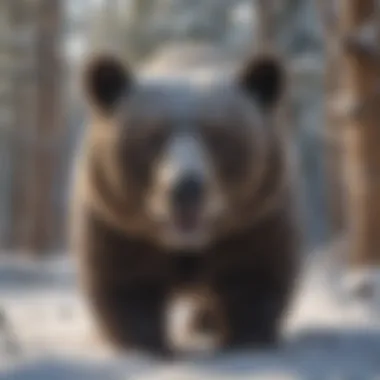Understanding Snowfall Patterns in Big Bear


Intro
Big Bear is a unique mountainous region located in Southern California, well-known for its stunning landscapes and winter recreation opportunities. The patterns of snowfall here are influenced by various geographic and climatic factors, which can be complex in nature. To fully understand these patterns, it is crucial to examine the interplay between local topography, weather systems, and historical snowfall data. This exploration aims to provide insights into the variability of snow occurrence in Big Bear, helping both locals and visitors alike to appreciate the nuances of its winter climate.
Understanding Woodland Ecosystems
The ecosystems surrounding Big Bear are rich and diverse. These wooded areas not only provide habitat for numerous species but also play a vital role in the broader environmental health of the region. Understanding the importance of biodiversity in forests is essential for appreciating how snowfall patterns influence local ecosystems.
Importance of Biodiversity in Forests
Biodiverse forests contribute to a variety of ecological services. They enhance soil stability, reduce erosion, and maintain water quality. Various tree species, such as the Jeffrey Pine and the Sugar Pine, thrive in Big Bear's unique climate, creating an interdependent relationship with the local fauna. The presence of such species demonstrates how snowfall patterns can dictate which organisms will thrive in this environment.
Role of Forests in Climate Regulation
Forests are not just passive bystanders in climate regulation. They actively influence local weather patterns. In regions like Big Bear, forests help to moderate temperatures and maintain moisture levels. Snowfall contributes to the process by providing insulation during winter months, affecting how quickly precipitation is absorbed by the soil as the snow melts in spring. This dynamic is crucial for the region's hydration and ongoing biodiversity.
"Understanding local ecosystems allows us to anticipate environmental changes and adjust our stewardship efforts effectively."
Sustainable Forestry Practices
Recognizing the significance of woodland ecosystems leads us to consider the management practices that can sustain them. Applying principles of sustainable forestry can help balance recreational needs with ecological preservation.
Principles of Sustainable Forestry
Sustainable forestry practices include maintaining species diversity, protecting water resources, and minimizing habitat destruction. These principles encourage the responsible extraction of resources while ensuring that ecosystems remain intact for generations to come. Techniques may involve selective logging, controlled burns, and monitoring wildlife populations to maintain a healthy forest ecosystem.
Case Studies of Successful Implementations
Examining successful implementations of these principles reveals how effective management can lead to thriving forests. For instance, the U.S. Forest Service has adopted practices in areas similar to Big Bear, promoting resilience against climate change and pests while maintaining recreational opportunities. The collaborative efforts of stakeholders have resulted in healthier ecosystems and better experiences for visitors.
Woodland Stewardship Techniques
Ultimately, stewardship techniques will define the long-term health of woodland ecosystems. Developing and implementing forest management plans is vital in this endeavor.
Forest Management Plans
A comprehensive forest management plan outlines clear objectives for conservation and recreation. Such plans often include assessments of current forest health, potential threats from climate change, and strategies for restoration. In Big Bear, these plans can ensure that snowfall patterns continue to support both nature and community goals.
Conservation Strategies
Conservation strategies play a key role in sustaining ecosystems. This might include protecting critical wildlife habitats or reintroducing native species that have declined. By examining how snowfall influences these efforts, communities can better prepare for future climate variability.
The interaction between snowfall and woodland ecosystems in Big Bear is complex and demands attention. By outlining these factors and management strategies, this article intends to provide valuable insights into the seasonal characteristics of snow and its broader implications for the local community and ecosystem.
Geographical Context of Big Bear
Understanding the geographical context of Big Bear is essential to grasp how the area's unique characteristics influence snowfall patterns. The combination of location, elevation, and natural features plays a crucial role in determining where and when snow will accumulate. Analyzing these factors exposes the intricacies of Big Bear’s climate and supports better decision-making for tourism, local residents, and conservation efforts.
Location and Topography
Big Bear is located in the San Bernardino Mountains of Southern California. Sitting at an elevation of about 6,750 feet, the area enjoys a semi-arid climate that significantly contributes to its snowfall patterns. The surrounding mountains surround the valley and their heights affect local weather conditions. Snow typically falls more frequently at higher elevations because cold air settles in these areas. The variation in altitude creates a microclimate, leading to differing snowfall amounts across the region.
When discussing topography, it is important to consider the unique features of Big Bear Lake itself. This basin plays host to various ecological zones, influencing temperatures and humidity levels. The lake also has a moderating effect on temperatures, which helps to create conditions that are conducive to snowfall during the winter months.
Key Points on Location and Topography:
- Big Bear’s altitude contributes to colder temperatures essential for snowfall.
- Surrounding mountains create varying weather conditions in different areas.
- Features like Big Bear Lake affect local climate, impacting snowfall amounts.
Climate Zones Classification
The climate of Big Bear is classified as a high desert climate, characterized by cold winters and mild summers. This classification means that while snowfall can be substantial, it often comes with significant fluctuations from year to year. Understanding these classifications is critical not only for predicting snowfall but also for grasping how these conditions affect local ecosystems and recreational activities.
In particular, snowfall in Big Bear is influenced by two distinct climate variables. The first is the Mediterranean influence that brings moist air into the region during winter months. The second is the cold Arctic air that occasionally flows into the area, creating conditions for significant storm systems that result in heavy snowfall.
Implications of Climate Zones:
- Recognizing climate classifications assists in forecasting snowfall patterns.
- Identifies potential ecological impacts based on climate variations.
- Provides essential insights for tourism and recreational planning in winter months.
Overall, understanding the geographical context of Big Bear is crucial for making sense of its snowfall patterns. By closely examining the location, topography, and climate classifications, we can better predict weather events and engage productively with the local environment.
Meteorological Factors Influencing Snowfall


The understanding of snowfall patterns in Big Bear heavily relies on various meteorological factors. These elements significantly affect both the amount and timing of snowfall, which in turn impacts local activities and ecosystems. By delving into the intricacies of temperature variations, precipitation patterns, and humidity levels, one can gain a thorough comprehension of how these factors interact to create the unique snowfall characteristics observed in Big Bear.
Temperature Variations
Temperature plays a crucial role in determining the type and amount of precipitation that falls as snow. In Big Bear, temperatures can fluctuate significantly, especially between day and night during winter months. Daytime warmth can melt snow, while colder nights allow for snow accumulation. This cycle of melting and refreezing can lead to icy conditions, which can affect outdoor recreational activities and safety.
Key considerations regarding temperature include:
- Elevation Effects: Higher elevations typically experience lower temperatures. Big Bear's topography sees temperatures drop enough for snow to form, especially in the late fall through early spring.
- Inversion Layers: On occasion, temperature inversions occur, where warmer air traps colder air below, impacting snow formation and retention.
Precipitation Patterns
Understanding precipitation patterns is essential to grasp how snowfall accumulates in Big Bear. The region experiences considerable variations in precipitation due to its geographical location. Depending on atmospheric conditions, the types of precipitation can vary significantly – with snow often being the most prominent during winter.
Noteworthy aspects of precipitation patterns include:
- Storm Systems: The arrival of winter storm systems brings moisture-rich air that cools as it rises, resulting in snow. Patterns of these storms greatly dictate snow depth and coverage.
- Leeward Effects: The surrounding mountains can sometimes shield Big Bear from certain storm patterns, leading to fluctuations in snow accumulation across seasons.
Humidity Levels
The impact of humidity levels on snowfall cannot be overlooked. Humidity refers to the amount of water vapor in the air, which affects cloud formation and precipitation. In Big Bear, humidity levels fluctuate throughout the winter, influencing how much moisture is available for snowfall.
Considerations related to humidity include:
- Snow Crystal Formation: Higher humidity can lead to the formation of different snow crystal shapes, affecting snow density and quality. Wet, heavy snow differs significantly from light, powdery snow.
- Dew Point Influence: The dew point indicates the temperature at which air becomes saturated with moisture, directly influencing how easily clouds can form and release snow.
"Variations in meteorological factors are vital for understanding how snowfall patterns shape not just the winter landscape but also the local economy and recreational opportunities in Big Bear."
In summary, examining these meteorological factors gives valuable insights into the snowfall patterns experienced in Big Bear. A comprehensive understanding of temperature variations, precipitation patterns, and humidity levels ultimately lays the groundwork for appreciating the complexities of Big Bear’s winter environment and its broader implications.
Historical Snowfall Data Analysis
The analysis of historical snowfall data is crucial for understanding the dynamics of winter conditions in Big Bear. This section provides insights into snowfall patterns that have occurred over the years. By examining this data, researchers, local officials, and caretakers can make informed decisions about resource management, ski area operations, and environmental health. Additionally, understanding historical snowfall patterns allows for a better grasp of how changing weather may impact the area in the future.
Year-By-Year Snowfall Records
To analyze snowfall accurately, detailed year-by-year records are essential. Over the years, Big Bear has documented snowfall amounts, which enables comprehensive assessments of trends and anomalies. These records are often compiled by local meteorological stations and authorities. They include the total snowfall for each winter season, broken down monthly. For example, the 2019-2020 season recorded a total of 20 feet of snow, with January being particularly heavy, contributing 8 feet alone.
Yearly variations in snowfall are evident. Some years may experience significant snowfall, while others see much less. This data can be visualized in graphs and charts, aiding in a clearer understanding of distribution and intensity.
Snowfall Trends Over the Decades
When analyzing snowfall trends over the decades, notable shifts become clear. Long-term data reveals fluctuations that might correlate with broader climatic patterns. For instance, the average snowfall in the 1980s was higher than in the 2010s, indicating a potential decrease in available snow. This reduction could have various implications, from ecosystem changes to economic shifts in ski tourism.
Understanding these trends is not only about snow statistics. It allows for deeper analysis of environmental conditions. The use of statistical methods to analyze these trends is commonplace. These methods enable researchers to predict future snowfall based on historical patterns. Furthermore, the implications for agricultural practices and ecology can be significant. Ski resorts might need to adapt their operations based on the predicted changes in climate and snowfall frequency.
"Historical snowfall data serves as a foundation for forecasting future conditions and preparing for ecological impacts in Big Bear."
In summary, historical snowfall analysis is central to a comprehensive understanding of snowfall patterns in Big Bear. This knowledge is vital for both local communities and the environment.
Typical Snowfall Season in Big Bear
The snowfall season in Big Bear is not just a climatic event; it holds significant implications for recreation, local ecology, and the economy. Understanding this season allows residents and visitors alike to navigate their winter activities effectively. The snowfall patterns drive both tourism and outdoor engagement while offering insights into local environmental conditions.
Peak Snowfall Months
In Big Bear, the months of December through February are regarded as the peak snowfall months. December kicks off the season with initial flurries, setting the stage for what's to come. January often presents the highest accumulation, due to cold air masses colliding with moisture-rich systems. February continues to deliver, although the amounts may start to taper off as the days lengthen.
Factors such as elevation and local atmospheric conditions lead to differences in snowfall within these months. The snowfall totals might vary, yet skiing and snowboarding enthusiasts rely on these periods for both consistent snowfall and excellent conditions.
Some relevant statistics include:
- Average January Snowfall: Approximately 60 inches
- Decade Comparisons: The last ten years have shown increased variability but also higher peak totals.
"Understanding when snow peaks allows for better tourism planning and resource management."
Variability in Snowfall Timing
While the peak months provide a general framework, the actual timing of snowfall can be quite variable. Anomalies can occur due to shifts in weather patterns influenced by larger climate phenomena such as El Niño or La Niña. These events can lead to unexpected snowfall, impacting planning and preparedness for residents and businesses.
This variability emphasizes the need for adaptive strategies in recreational planning and environmental stewardship. Local weather monitoring, combined with historical data, can aid in predicting these shifts.
In summary, understanding both the peak months and the variability in timing is critical for stakeholders in the Big Bear region. This knowledge assists in maximizing outdoor activities while preserving ecological balance.


Impact of Climate Change on Snow Patterns
Climate change significantly alters snowfall patterns in Big Bear, impacting not just winter sports but the entire ecosystem. Understanding these changes is crucial for local communities and stakeholders involved in recreation, tourism, and environmental management. Increased temperatures affect how much snow falls and its overall consistency, leading to variability that could impact local ski resorts and winter enthusiasts.
Changing Snowfall Totals
In recent years, the snowfall totals in Big Bear have shown a concerning trend. Studies indicate that snow accumulation has become less reliable. Average snowfall may decline due to warmer winters, influencing both the volume and duration of snow cover. Historically, Big Bear experiences substantial snowfall, but a changing climate is pushing thresholds. This has implications for water supply too, as the region relies on snowpack, which melts and contributes to runoff.
The following factors are influencing snowfall totals:
- Temperature Increases: As temperatures rise, the likelihood of precipitation falling as rain instead of snow increases.
- Changing Storm Patterns: Altered weather patterns can lead to more erratic snow events, resulting in peaks of heavy snow followed by dry spells.
- Evaporation Rates: Higher temperatures also increase evaporation, potentially reducing overall moisture availability in the atmosphere to create snow.
This variability in snowfall can lead to confusion among residents and tourists, as well as challenge resource management efforts in the area.
Implications for Local Ecosystems
The implications of changing snowfall patterns on local ecosystems are profound and multifaceted. Wildlife that depends on predictable snow patterns for habitat and food sources is especially vulnerable. For instance, species that rely on snow cover for camouflage or to access food may find their survival threatened.
Moreover, altered snowfall affects soil moisture levels. When snow melts unevenly or earlier than usual, it can disrupt the water cycle. This may lead to drought conditions during critical growing seasons, thus harming plant life that depends on consistent moisture levels.
"Ecosystems rely on stable conditions; changes in snow patterns could disrupt intricate relationships between species and their environments."
Additionally, the timing of spring melt influences stream flows. If snow melts too quickly, it can lead to flooding, adversely impacting fish populations and other aquatic ecosystems. Conservation strategies must evolve to account for these changing conditions to protect both flora and fauna in Big Bear.
In summary, climate change introduces new challenges for snowfall patterns in Big Bear. Both the totals and timing of snowfall are shifting, creating a ripple effect on the environment. Understanding these dynamics is essential for those involved in forestry, tourism, and ecological preservation.
Recreational Activities and Snow season
The snowfall season in Big Bear is not just about the white landscapes; it brings an array of recreational activities that attract locals and tourists alike. Understanding these activities is vital in appreciating how snowfall patterns shape the experiences of visitors and residents. The diverse winter sports and outdoor adventures depend significantly on snow conditions, which vary annually. These variations influence the timing and availability of activities such as skiing, snowboarding, snowshoeing, and winter hiking.
Winter recreation fosters a strong sense of community and boosts local economy through tourism. When snowfall is plentiful, Big Bear transforms into a hub for winter sports enthusiasts. Additionally, the enjoyment and connection to nature during this season promote mental well-being. It is crucial for both new and seasoned visitors to understand how seasonal snowfall impacts options for outdoor activities.
Skiing and Snowboarding
Skiing and snowboarding are the main attractions during the winter months in Big Bear. These activities are offered at popular resorts like Bear Mountain and Snow Summit. The quality and quantity of snow significantly affect the skiing experience. Fresh snowfall often leads to better conditions on the slopes.
Many ski resorts implement snowmaking systems to supplement natural snow. This approach ensures that visitors have access to quality terrain, regardless of the natural snowfall amount. Skiers and snowboarders often check snowfall reports before planning trips.
Several courses cater to different skill levels, from beginners to advanced. Lessons are available, providing opportunities for novice skiers or boarders to learn from experienced instructors.
The variety of slopes allows for personalization of the experience. With family and friend groups, skiing can be both competitive and enjoyable.
Snowshoeing and Winter Hiking
Snowshoeing and winter hiking activities offer a different perspective on the snowy landscape. These practices allow individuals to explore nature at a slower pace compared to skiing. Trails provide a variety of experiences, from serene walks through the forest to challenging hikes that lead to panoramic views.
Snowshoeing is often seen as an accessible alternative for those who want to enjoy the outdoors without the high speeds of skiing or snowboarding. Necessary gear is simple, and many local shops offer rentals for those new to the sport.
Winter hiking can also include activities like wildlife observation or photography. Snow-covered landscapes provide unique opportunities for capturing nature’s beauty. Hikers need to prepare adequately for sudden weather changes, ensuring safety during their excursions.
In summary, these recreational activities are vital during the snow season in Big Bear. They offer diversified experiences and foster a connection to nature while benefiting the local economy.
Local Economy and Winter Tourism
The interplay between snowfall and the local economy in Big Bear is undeniably significant. This area relies heavily on winter tourism, making snow conditions a vital aspect of economic stability. The influx of visitors during the snowy months generates income for various sectors, including hospitality, retail, and outdoor recreation. Each snowfall shapes the expectations of tourists and influences their choices regarding travel and activities. When the amount and quality of snow meet or exceed the expectations, businesses thrive; conversely, poor snowfall can dampen tourist interest and economic activity.
Effects of Snowfall on Tourism
Snowfall directly correlates with tourism in Big Bear. Each winter, an anticipated number of visitors come for skiing, snowboarding, and other snow-related activities. Ski resorts, such as Bear Mountain and Snow Summit, rely on consistent and ample snowfall to operate effectively. High snowfall not only boosts skier satisfaction but also enhances the overall experience, often leading to repeat visits.
Tourism statistics show that when snowfall is abundant, the rates of bookings increase. Lodging establishments report higher occupancy during peak snowfall months, which contributes directly to the local economy. Furthermore, restaurants and shops benefit from increased foot traffic as visitors seek local meals and gear. This symbiotic relationship highlights the necessity for snow in maintaining a healthy economy during winter.
Business Adaptations to Snow Events
Businesses in Big Bear must maintain flexibility regarding snow conditions. Adaptations to snowfall variations are essential to maximizing profitability in unpredictable winter seasons. For instance, resorts often develop snow-making capabilities to ensure that they can still provide an adequate skiing experience, even during a less snowy year. This investment in technology reflects the serious nature of climate impacts on snowfall and tourism.
Moreover, local businesses diversify their offerings, planning events and activities that attract visitors regardless of snow levels. For instance:
- Winter festivals and holiday markets draw crowds irrespective of the weather conditions.
- Indoor activities such as spa services or craft workshops provide alternative entertainment options.
In essence, staying ahead of snow variability is critical. Businesses that can adjust to the seasonal dynamics and consumer preferences not only survive but often thrive.


"Understanding the impact of snowfall patterns allows businesses to prepare and adapt, ensuring the local economy remains robust during winter months."
This proactive approach highlights an awareness of both climate impacts and economic sustainability, crucial for Big Bear's continuous growth as a winter destination.
Environmental Stewardship in Snowy Conditions
Environmental stewardship becomes critical when discussing snowfall patterns in Big Bear. This focus helps maintain the balance between recreational activities and preserving the natural habitat. Understanding snow impact on local ecosystems ensures that we can enjoy winter sports while caring for wildlife and forest health.
During the winter months, snow covers the landscape, and it changes how local flora and fauna behave. Snow provides insulation to the ground, protecting plant roots and allowing ecosystems to function. However, heavy snowfall can also lead to challenges for wildlife. Animals may struggle to find food and shelter, making habitat management essential.
Key benefits of environmental stewardship include:
- Biodiversity Protection: Aiming to maintain species that depend on snow-covered areas.
- Sustainability: We can achieve long-term ecological health by implementing responsible practices.
- Community Awareness: Educating the public on the importance of balancing recreation and conservation efforts enhances community involvement.
These points underscore the importance of recognizing our role in managing the environment amid snowy conditions.
Managing Snow Impact on Wildlife
Managing the snow impact on wildlife is vital in Big Bear. With the onset of winter, many species face difficulties caused by snow accumulation. Larger mammals, such as deer, may find it harder to traverse deep snow, limiting their ability to access food. Conversely, small mammals may be at a disadvantage due to predation risks.
Conservation strategies include:
- Monitoring wildlife movements and behavior during snow seasons.
- Implementing controlled feeding areas to assist struggling species.
- Ensuring winter recreation activities are monitored to minimize habitat disruption.
Understanding these impacts can lead to better strategies for protecting wildlife. Considering these factors helps ensure that winter tourism does not come at the expense of our local fauna.
Sustainable Forestry Practices in Winter
Sustainable forestry practices during winter months are essential to maintaining forest health in the Big Bear region. The presence of snow can alter not just the forest floor but also how we manage timber resources. It is crucial for forestry professionals to consider seasonal dynamics when planning operations.
Some practices include:
- Selective logging techniques that minimize disturbance to the forest floor, preserving soil quality and protecting plant species.
- Timing operations to avoid peak snowfall periods, reducing the risk of soil compaction and damage during thaw cycles.
- Utilizing snowpack for natural insulation to protect saplings and young trees.
Investing in sustainable forestry practices can boost the resilience of the ecosystem, ensuring it continues to thrive in the face of climate variations.
"Environmental stewardship in snowy conditions not only benefits local wildlife but promotes a healthier ecosystem overall, fostering balance between recreation and conservation efforts."
This management approach increases the ecological integrity of the region while maintaining its allure as a winter destination. The thoughtful balance initiated through sustainable practices ensures that Big Bear can remain a beacon of environmental responsibility.
Future Predictions for Snowfall in Big Bear
Understanding future snowfall predictions in Big Bear carries significant weight for various stakeholders, including local governments, tourism operators, and environmentalists. These predictions help to assess how changing weather patterns can affect not only the seasonal appeal of the region but also its ecological balance and economic prosperity. As climate change continues to alter precipitation patterns and temperature ranges, it becomes crucial to analyze potential scenarios that may emerge in the coming years.
Modeling Future Snowfall Scenarios
Several models exist to project future snowfall scenarios in Big Bear. These models typically utilize historical data as a baseline and incorporate various climatological variables to provide forecasts.
- Climate Models: Advanced climate models like the Community Earth System Model (CESM) can simulate how shifts in global temperatures may influence local snowfall. These models factor in greenhouse gas emissions, ocean conditions, and atmospheric circulation patterns.
- Statistical Approaches: Using regression techniques, researchers analyze past snowfall data against temperature trends to forecast future changes. By identifying correlations, they can present scenarios that illustrate possible increases or decreases in snowfall totals.
- Predictive Analytics: Integrating machine learning algorithms can result in more nuanced predictions. These models can adapt as new data emerges, refining predictions over time to reflect real-time conditions.
"Accurate modeling not only informs local planning but also prepares residents and businesses for the uncertainties of weather extremes."
These modeling efforts provide a basis for strategic planning. Local governments can use such insights to prepare infrastructure for potential changes in snow levels.
Community Preparedness for Snow Variability
As snowfall variability increases due to climate change, community preparedness becomes essential. This aspect involves proactive measures to safeguard residents and maintain economic stability during unpredictable winter conditions.
- Emergency Plans: Local authorities should develop emergency response plans that can be activated during extreme snowfall events. This includes clear communication strategies and resource allocation for snow removal and emergency services.
- Community Engagement: Educating residents about expected changes in snowfall patterns and practical preparations can mitigate disruptions. Workshops and information sessions can inform citizens about snow safety and winter preparedness strategies.
- Infrastructure Investment: Investing in infrastructure tailored to handle variable snowfall can protect against damage. This includes enhancing drainage systems to prevent flooding from rapid snowmelt.
Ending
Summary of Key Insights
In synthesizing this information, several key insights emerge:
- Big Bear's geographical location and topography play a crucial role in its snowfall patterns. The elevation and orientation significantly influence how much snow accumulates during the winter months.
- Meteorological elements, such as temperature variations and precipitation levels, inform how snow develops and its subsequent behavior on the land.
- Historical snowfall data illustrates profound trends, including fluctuations over the decades, allowing for assessment of both natural variability and shifts attributed to climate change.
- Understanding snowfall patterns is essential for recreational planning and supports local economic activities like winter tourism, which are highly dependent on consistent and predictable snowfall.
- The effects of climate change raise important considerations around local ecosystems, necessitating proactive management and community preparation for alterations in snowfall.
This culmination underscores the importance of a comprehensive grasp of snowfall patterns, not only for recreational opportunities but also for sustainable practices in Big Bear’s enduring relationship with its environment.
Call to Action for Environmental Engagement
As we reflect on snowfall dynamics and their implications, there emerges a pressing need for environmental engagement. Individuals, communities, and organizations should consider several actions:
- Promote Awareness: Increase understanding of how personal actions can impact snowfall and climate variables through educational programs and community workshops.
- Support Conservation Efforts: Participate in local initiatives aimed at preserving natural habitats and managing forest resources wisely, especially during the winter months.
- Engage in Research: Encourage and get involved in local research that explores climate impacts and its effects on snowfall patterns.
"Engagement in these actions not only benefits the local ecosystem but also fosters resilience against impending climate challenges."
Through these efforts, the community can work towards balancing recreational desires with sustainable practices, ensuring Big Bear remains a vibrant and ecologically sound environment for generations to come.







